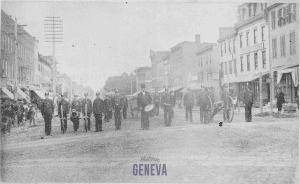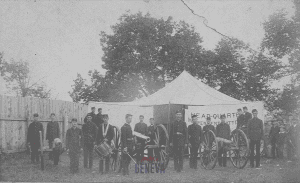Battery Boys: The Independent Battery
By Becky Chapin, Archivist
The Independent Battery was formed on September 20, 1879, sponsored by the Grand Army Republic Swift Post No. 94 in Geneva. During a sham battle held in Phelps, members of the local GAR felt inspired to sponsor a battery of field artillery composed of young men from Geneva. Following, the charter members were William McCoy, Edward Moaw, — Musket, George Wood, — Thornton, John Slattery, Ted –, Charles W Fairfax, William Connell, FS Clarkson, WH Gaylord, Henry DeForest Patterson.
The GAR purchased double-breasted blue uniforms, regulation caps, white leather belts, and swords for the “Battery Boys.” The first captain was William H Gaylord.
Patterson was then elected captain, a role in which he served until 1888 when he moved to Rochester. The Battery drilled in the Hook and Ladder Fire Company rooms until they started leasing a third-floor room from Roenke and Rogers in 1886. The same year, the Battery sought advice from the US Ordnance Department about cannons that would match their artillery.

The Independent Battery were on their way to Sodus Point in 1884 and formed a battle array on Exchange Street, facing south, to get their photo taken by Abel S Hinckley.
Rough castings were taken to the New York Central Iron Works downtown and William B Dunning oversaw the turning and boring of the cannons. Patterson made drawings for a gun carriage for 3-inch guns that matched the old Reynolds Battery. These were sent to Charles Fairfax who supervised the steel work and made the regulation gun carriages and limbers with Keyes and Son (BW Keyes, a GAR man).
The Battery formed an indoor baseball team and bowling team. It raised money through their moonlight excursions and dances in their home at Irving Hall, later renamed Battery Hall. (This was 66 Seneca Street, formerly Smith Block and what became known as the Guard Block. After the Battery had its home here, the building burned down a few times and was rebuilt.)
The Independent Battery was in high demand. It traveled throughout the surrounding counties and into Pennsylvania to supply cannon fire for various events like the Fourth of July, opening GAR encampments, after elections, and for memorials in Geneva like General Ulysses S Grant and President William McKinley. The Battery was also asked to participate in a play called Confederate Spy. Held at the Smith Opera House, the play advertised the 34th Separate Company and the Independent Battery with their cannon.

The Independent Battery on location, presumably at a GAR encampment, 1900s under the leadership of Captain Charles Fairfax who had served with the 34th Separate Company during the Spanish-American War.
Their services were engaged to open local Emancipation Celebrations in Geneva and other locations like Watkins Glen. At one time, their drummer was William Connell, a man of color, and founding member, who later enlisted in the regular army cavalry and was stationed in Jefferson City, Missouri.
In 1898, their services were (partially) used to blow up the steamboat Onondaga. Member Louis Klopfer recalled the incident:
A big steam scow was brought in from which the blast was touched off by pulling a long rope that tripped some kind of mechanism. Our Independent Battery was aboard this…just before the big blast was to come off, we fellows with [the] Battery played a joke on everybody. We had brought our cannon, and, when the excitement was at its highest pitch, we let go with a loud shot. For an instant the crowd thought it was the real business.
When the Onondaga blew up it looked just like the pictures you see of ships doing the same thing. Right away the spot was crowded by boats picking up lumber, and a day or two later ‘souvenirs of the Onondaga’ appeared for sale on the streets of Geneva. But the time seemed too short for so many well made items to have come from that lumber. I bought a small wooden pail about six inches high.
The Battery would see off Company B when they went to break up strikes in Buffalo (1892), to the Spanish-American War (1898), to World War I (1917), and to welcome them home again. In a history he wrote in 1929, Patterson recalled nearly all the dead of the World War went to their graves on the guns carriage of the Battery.
Several reunions were organized starting about 1909 for old and new members to talk about their experiences. A total of 171 people were listed on the rosters from 1879 until 1923, with less than half still living in Geneva. The final event was at Lakeside Park, a gun salute for the passing of President Warren G Harding in 1923.
Dwindling GAR posts and associations discontinuing encampments, alongside fewer Fourth of July celebrations, meant the Battery was no longer attending so many events. Instead, an Independent Battery Veteran’s Association was formed, though briefly lived. Eventually, their guns were formally dedicated and given to the American Legion Winnek Post in 1933. The group was still fondly remembered as the Battery Boys into the 1950s.
This article was brought to you in part by our supporters. Be our partner in telling Geneva’s stories by becoming a Historic Geneva supporter.

Becky, Another great article about Geneva’s history.